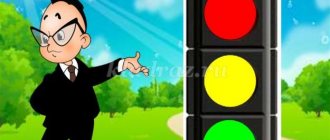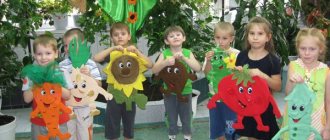Educational game Djeco “Numbers” (Ozon, My-shop)
A very good set for practicing your very first counting skills. The rules present as many as 4 variants of the game, both the most banal (combine numbers and quantities) and the most common ones. We especially liked one of them. Here's the gist of it: each player takes a playing field with empty silhouettes of animals. When throwing the dice, players must fill their fields with chips. We place the number of chips on the field as many as the dice shows up. Moreover, on the last move, exactly as many dots should appear on the cube as there are empty cells left on the field; if you are unlucky, we wait for the next move. Naturally, the winner is the one who is the first to completely collect all the kittens/puppies/hares/ducks.
The number of dots on the cube does not exceed three, so a 2-year-old child can easily handle the counting.
The execution of the set, as usual from Djeco, is excellent, the chips and cards are pleasant to hold in your hands, they are durable and will definitely last a long time. Still, the price for Djeco “Numbers” seems to me too high, and it’s not easy to find a set on sale lately, so I’m posting a scanned version of the game just in case. The kit can be DOWNLOADED HERE .
Board games for children 2-3 years old (younger group)
Children 2-3 years old often do not yet speak, do not recognize differences in colors and shapes, and do not know the names of objects. The teacher needs to offer such children board games to develop speech, visual and auditory perception, and attentiveness. The children cannot yet play together without the help of an adult, so the teacher acts as a coordinator and mentor in the kindergarten group.
Children of the younger group are very inquisitive and interested in everything new to themselves. Invite them to play bright pyramids, picture lotto, large puzzles, and build towers. Each game should be bright, beautiful and as safe as possible. No small parts (chips, cubes), sharp objects - the kindergarten by default should be a place where it is always safe for the child. You can make a finger theater with your own hands and offer to act out a scene with your children.
| “Guess and name” Pictures depicting various objects (fruits, transport, birds, etc.) come out of the box. The child must name what he sees. |
| “Where is whose house?” The kids’ task is to correctly match the animals with their habitat. These can be printed puzzles, purchased pictures, magnets or magnetic boards. |
| “The fourth extra” The excess is removed from the proposed options for animals, plants, insects, birds, food and other things. The child himself must determine the sign by which to make a choice - in case of failure, the teacher prompts, starting a speech from afar. |
Balancer scales
According to our observations, this board game for children also becomes interesting after 2.5 years. And again, the players take turns throwing a different-colored die here. Having thrown out, for example, red, the player must put a red cylinder on the scales. In this case, you need to be very careful not to drop either yours or the previously installed cylinders. The loser, naturally, is the one whose entire structure collapses. The balance beam develops clarity of movements, accuracy and, of course, also teaches you to play by the rules: it teaches you to wait your turn, and it also gives the child the understanding that not only he can win.
By the way, we have come up with another version of this game: you can not only stack the cylinders on the scales, but also build a tower out of them, also guided by the color that appears on the die.
Pull out the carrot
The dynamic popular game from Ravensburger “Pull the Carrot” (“Funny Bunny”) is positioned as a board game for children 5-9. However, the rules are not complicated; three-year-olds are already quite accessible. This is one of the most popular board games for children.
Rules of the game “Pull the Carrot”: The player must be the first to reach the top of the hill. If a carrot is drawn on the card, then the most interesting moment comes - you need to turn the large carrot in the center of the playing field. When you rotate the carrot, a hole opens on the path.
If there is a bunny , then it fails and the player must take another bunny. Many people rotate the carrot after each move to make the game even more fun.
Board game PULL THE CARROTS see price in Russia
Here is a cheap analogue of the board game on Aliexpress.
Domino (Labyrinth, My-shop, KoroBoom)
Another classic game is dominoes. Naturally, at the first stage you will need a domino with pictures instead of dots. Most likely, the child will not yet be able to master the full version of the rules, but he will definitely be able to play the simplified version. We began to get acquainted with dominoes at the age of 1 year 9 months, then we simply built paths from it, simply combining pictures on dominoes. Later they began to take turns, and also differentiated the common pile of dominoes into “yours and mine.” I think now we can try to explain the full rules to my daughter (she is now 3 years old).
Bunnies (Ozon, My-Shop, KoroBoom)
This is a game that hooks children with almost 100% probability. Even if the kid doesn’t want to play by the rules, he will definitely enjoy putting together a fairytale field like a construction set and playing out simple stories on it. I think the main secret to the success of this board game is the 3D playing field, plus the interesting idea of harvesting in the garden.
To be honest, I bought this board game when my daughter was noticeably older than 2 years old (and she just stuck to it). But I’m including it in the selection of games for the little ones, because we took out the game many times when the kids came to visit, the game always went with a bang. Here the child only needs to count within three, the rules are also simple (only parents need to figure it out first, because the instructions are written quite intricately).
The main objective of the game is to go into the garden through a free hole in the fence and pick cabbage or carrots there (depending on the number of dots dropped). You need to quickly go home with your catch, and then go again for the next portion. Naturally, the winner is the one who reaps the most significant harvest.
Lotto (Labyrinth, My-shop, KoroBoom)
And, of course, don’t forget about everyone’s favorite classic games. You can start getting acquainted with lotto as early as one year, I have already written about this. Closer to two years, the child can not only put cards in the right places, but also play according to simple rules with his opponent. Let’s say that dad and child each receive a playing field, and mom takes cards out of the bag in random order (or almost randomly :)) and announces “Who has a hippopotamus?” The first one to collect all the cards on his field wins.
Lotto is also great because while playing you can unobtrusively study any interesting topic - animals, plants, professions, geometric shapes, etc. All names will be remembered by the child quickly and easily.
Memory (KoroBoom, Labyrinth, My-shop)
I think this game is also familiar to everyone from childhood. Here you can also try playing alone first, and then together. For those who are not familiar with the rules, I will briefly explain. A certain number of cards are taken, for example, 8 to start with, laid out on the table with the pictures facing up, and the name of each picture must be spoken out. Next, all the cards are turned face down and you need to remember from memory where each picture is. If two people are playing, then each player takes the cards they guessed, and at the end of the game they are counted.
In memory games, all the cards can be different (in Shichida’s method this is called a memory grid), or they can be paired (then the goal is to find pairs). Taisiya and I began to master the first memory at 1 year 9 months, starting with a small number of cards. At this age, the essence of the game is already clear.
Memory, like lotto, helps you learn new concepts and topics. For example, if you choose cards with exotic animals, during the game you can get acquainted with unfamiliar species of animals, etc.







